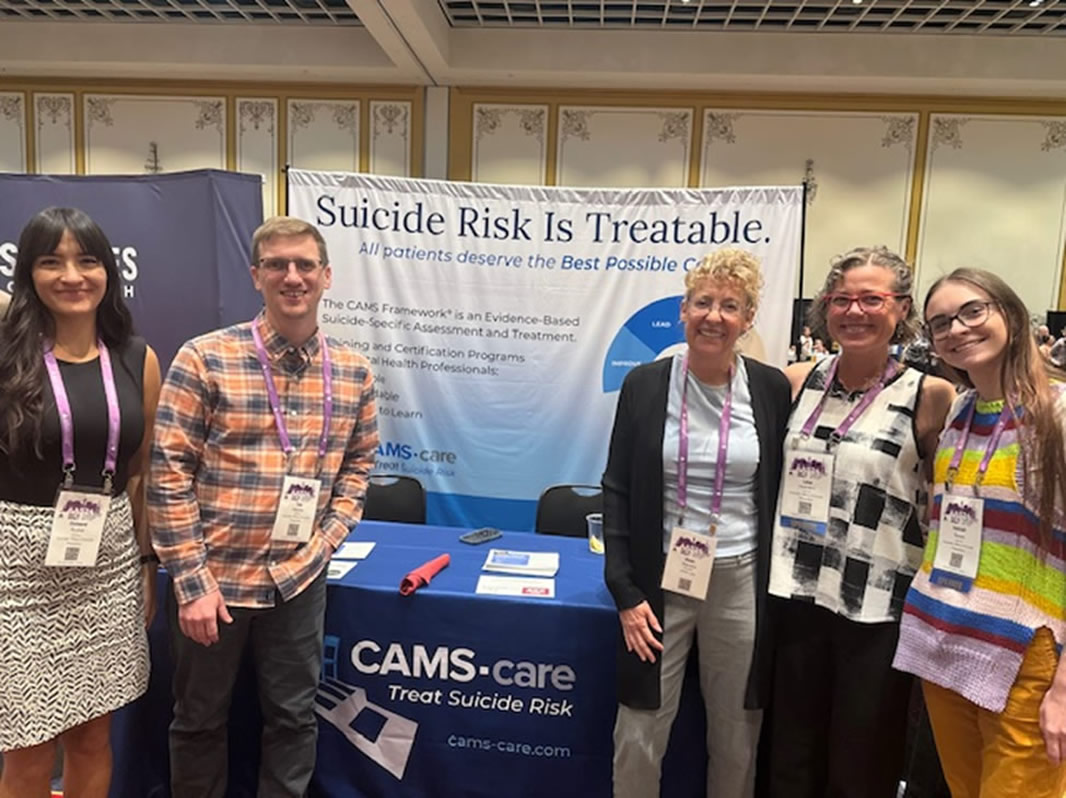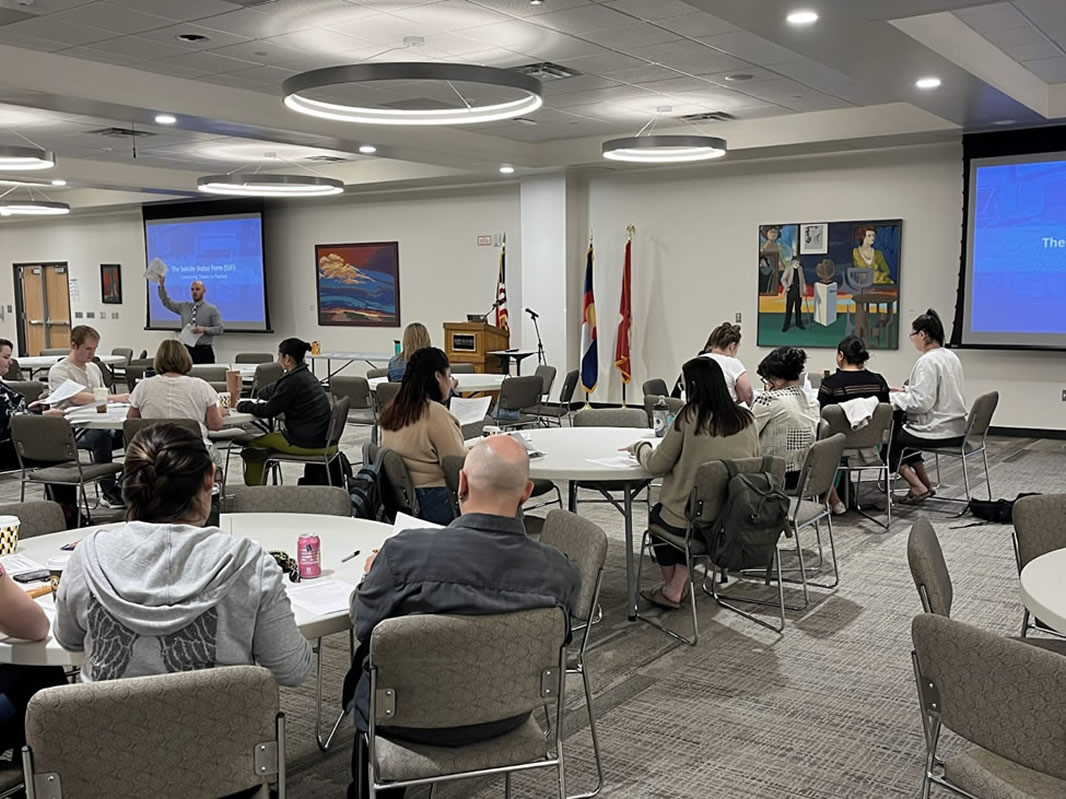
Colorado has historically faced some of the highest suicide death rates in the United States. In 2020, 21.5 per every 100,000 people died by suicide, compared to 13.5 per every 100,000 people nationally. However, in 2022, after a 15-year high, Colorado’s suicide statistics began trending downward. Since then, suicide rates have remained steady and show promising signs of continued improvement.
Behind this remarkable progress is the Colorado Office of Suicide Prevention (OSP)—a small yet mighty team leading the state’s suicide prevention, intervention, and postvention efforts. By securing competitive state and federal grant funding, implementing a comprehensive suicide-care strategy rooted in evidence-based practices like the Collaborative Assessment and Management of Suicidality (CAMS), and addressing diverse community needs, Colorado is catalyzing lasting change and providing a blueprint for other states and organizations to follow.
The Colorado Office of Suicide Prevention (OSP)
OSP was established in 2000 within the Prevention Services Division of the Colorado Department of Public Health and Environment as the state’s lead entity for suicide prevention. Under the leadership of Director Lena Heilmann, the dedicated team of eleven works tirelessly to enhance suicide-specific care across the state.
Anchored in six core pillars—Connectedness, Economic Stability, Education and Awareness, Improving Access to Safer Suicide Care, Lethal Means Safety, and Postvention—OSP collaborates with communities and agencies across every county in Colorado to develop and implement equitable strategies to reduce suicidal despair, attempts, and deaths. Funding local initiatives, fostering collaborative partnerships, targeting high-risk populations and areas, and training individuals to handle suicidal crises, are a few components of their comprehensive, statewide approach.
Despite resource limitations, competitive state and federal grants have made their growth, strategic approach, and progress possible.
Three Foundational Elements of OSP’s Success
1. Maximizing Resources through Federal Grants
OSP leverages competitive state and federal funding to support its comprehensive, community-based approach to suicide-specific care. They maintain continuous efforts by leveraging diverse funding sources, avoiding funding shortages between grants.
To date, OSP has secured all eligible federal grant options. For example, in FY 2022-23, of their $5.19 million budget, $3.3 million came from federal grant funds, including:
- SAMHSA Zero Suicide Federal Grant
- SAMHSA GLS Youth Suicide Prevention Federal Grant
- SAMHSA National Strategy for Suicide Prevention Federal Grant
- CDC Comprehensive Suicide Prevention Federal Grant
- Public Health and Human Services Block Grant
The evidence-based Collaborative Assessment and Management of Suicidality (CAMS) and Zero Suicide frameworks are critical components of comprehensive suicide prevention. OSP collaborates with the CAMS-care team to secure grants, embedding both frameworks into their grant funding to achieve specific goals and enhance suicide prevention efforts.
2. Implementing a Comprehensive and Aligned Approach
OSP collaborates with and engages various stakeholders, including communities and agencies across Colorado, to coordinate suicide prevention programs and efforts. Their comprehensive state-wide approach includes:
- Funding local initiatives
- Targeting high-risk populations and areas
- Implementing primary prevention strategies
- Training individuals to respond to crises
- Addressing lethal means safety
- Supporting those impacted by suicide
- Leading collaborative partnerships
Embracing the Whole System of Care
OSP’s unified strategy, based on a comprehensive approach that Zero Suicide plays a critical role in, ensures they address all aspects of suicide prevention, intervention, and postvention. This creates a seamless continuum of care for individuals to receive the best possible support. This holistic approach allows for early identification and intervention, continuous support throughout recovery, and effective postvention efforts to mitigate the impact of suicide on families and communities, ensuring no one falls through the cracks.
Prioritizing CAMS and Zero Suicide Frameworks
Evidence-based frameworks, such as CAMS, are the most effective suicide treatment methods. OSP incorporates these frameworks into their health systems, supporting training, suicide-specific care plans and continuous quality improvement activities across the state. For example, through the 2018 GLS grant, OSP trained 980 providers in CAMS during five training programs. More recently, in FY 22-23, they trained 350 providers during six training programs.
The flexible nature of CAMS allows for its adoption across various demographics and care settings. OSP’s initiatives have encouraged providers to integrate CAMS into everyday practice, spurring a cultural shift within the entire system of care toward more empathetic, honest, and trust-based patient interactions. As CAMS training becomes standard, it ensures consistent, high-quality care despite clinician turnover, improving suicide prevention practices statewide.

Tailoring Interventions through an Equity Lens
OSP prioritizes equity in its programming, customizing interventions to the specific needs of different demographics and communities. OSP targets groups with the highest suicide rates in Colorado, such as LGBTQ+ individuals, veterans and their families, and workers in high-risk industries, such as construction, oil and gas, and first responders. This helps ensure that their initiatives include culturally appropriate information that address the needs of these communities.
Director Lena Heilmann reflects, “The more comprehensive and aligned our programs are, the more reductions we see in suicide fatality rates. That level of coordination and thoughtfulness will hopefully keep our rates in the direction of decreasing.”
3. Addressing Diverse Communities through Innovative Solutions
OSP meets community needs by observing what works and adapting strategies when necessary. In close collaboration with CAMS-care, they use innovative solutions to enhance their suicide prevention efforts. Recent examples of how OSP and CAMS have collaborated to amplify efforts span boosting training participation numbers to developing the clinician locator.
Training Engagement
When OSP received the GLS grant in 2018, they initiated five CAMS trainings statewide. Unlike the areas of Loveland and Lakewood that saw high attendance, Pueblo only had nine attendees. However, these nine attendees were so impressed with how in-depth the training was that they brought their organizations the following year, increasing participation.
Clinician Locator
When community partners began asking OSP for a list of CAMS Trained™ providers, OSP approached CAMS-care for help. Together, we launched the CAMS Clinician Locator to connect people to CAMS-trained providers, with options to filter by those who serve youth, offer telehealth, and accept Medicare and Medicaid.
CAMS Certification and Train the Trainer Programs
Following high participation rates in recent CAMS trainings, OSP is emphasizing advancing providers from CAMS Trained to CAMS Certified™ to meet higher standards of evidence-based care. Additionally, they are funding a number of CAMS Certified clinicians to become CAMS Internal Trainers to create more sustainable training practices and facilitate quicker onboarding of new staff.
Highlights of Colorado’s Success
Securing competitive grant funding, implementing a comprehensive and aligned approach, and meeting the community’s needs have not only elevated Colorado’s quality of care but also contributed to notable successes in the state’s fight against suicide.
In addition to the overall decrease in its state age-adjusted suicide mortality rate, other impressive state-wide statistics thanks to OSP’s efforts include:
- Decreased youth suicide deaths: In 2022, the youth suicide rate dropped to 8.53 per 100,000 from 13.06 per 100,000 in 2021.
- Increased support for youth: In 2021, over 73.5% of high school students reported that they had an adult to go to for help with a serious problem.
- Decreased Emergency Department visits: The age-adjusted rate for suicide-related visits dropped from 162.12 per 100,000 in 2018 to 151.92 per 100,000 in 2022.
- Decreased hospitalizations: Suicide-related hospitalizations dropped from 3,165 cases (56.01 per 100,000) in 2018 to 2,734 cases (47.51 per 100,000) in 2022.
These are just a few of OSP’s many key FY 22-23 successes. Most recently, the 2024 National Strategy for Suicide Prevention highlights OSP’s work as a model for supporting upstream comprehensive community-based suicide prevention.
A Blueprint for Saving Lives
The Colorado Office of Suicide Prevention has laid a solid foundation for continued improvement in suicide fatality rates across the state. The Zero Suicide and CAMS frameworks serve as cornerstones of this foundation, driving suicide-related outcomes in a positive direction. While much work remains until the suicide mortality rate reaches zero, OSP’s approach serves as a powerful model for other state and local organizations to follow.
Wherever you are in your suicide prevention journey, CAMS-care is here to support you. Whether you are looking for help applying for state or federal grant funding, repurposing existing funding into a more effective strategy, or finding the latest suicidology resources, we would love to hear from you. Contact us anytime.
Together, we can elevate suicide-specific care and save more lives.